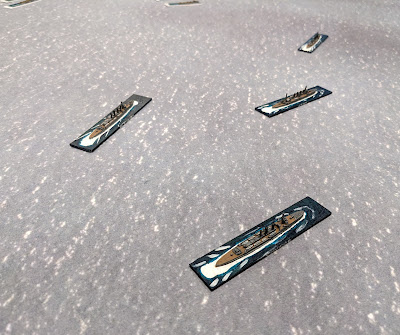I tried something new last night as Ralph put on a game of 'Broadside: Empire of Steel', which is a newish set of rules for WW1/Dreadnaught-era battles.
Ralph put together a scenario which saw both British and Germans running four light cruisers entering from opposite corners and looking to exit off the other side's corner. Pretty simple. But each side would get reinforcements of increasing weight as the action progressed, meaning the cruisers would have to be protected as they made their journey.
For some reason our cruisers scattered. Neat formations didn't seem to be a feature of our game at all.
Early in the game the British got some destroyers. The Germans didn't have destroyers in their reserve pool; I think they had more (or better) heavier cruisers and battlecruisers than we did.
The destroyers headed straight for the German light cruisers.
Much fighting ensued ...
... and little photography. I tried this arty shot but ballsed up the focus and failed to check it afterward. That blur at the front is the protected cruiser HMS Edinburgh. But it's a nice shot of Theo and Stuart planning their Teutonic shenaningans..
By the end of the evening the German light cruisers had taken a pasting, after their plan of boldly dodging down the table as fast as possible failed in a hail of torpedoes and (eventually) gunnery from HMS Edinburgh and the late-arriving HMS Invincible. To be fair the British light cruisers still had to run the gauntlet of the German battlecruisers, but at least they'd be doing it with support from the larger British ships and what remained of our destroyers. So we kind of called this a British win.
What of the game? Well, this isn't an era I'm that familiar with nor one I have a lot of interest in, so I can't attest to its authenticity. It was pretty simple to play. Turns have players alternating moving ships, with each ship firing after movement. Each ship can be given an order which will boost some aspect of its performance (turn better, move faster, shoot better) or do a special action (launch torpedoes). Generally it will always obey this order, but if under pressure (damaged, taking fire) the ship will have to dice to continue the order. Changing a ship's order also requires a test, with negative modifiers if under fire or damaged. So all ships can move, turn and shoot, but the better-disciplined ones can do things better. I quite liked that aspect of it.
Firing was fairly straightforward - you do a single roll to hit. If you miss then you get a splash marker which makes it easier to hit next time, and these accumulate, up to three. If you do hit then you place all three splash markers to show that you've ranged in, and the target gets a save roll against the number of guns in the salvo. You then roll damage for each tube that's not saved, based on the weight of the gun and the target's armour.
There's a slightly different mechanism for torpedoes, and for secondary guns which fire direct and therefore hit more easily but only at close-range.
Basic damage is simple hits - when they reach zero the ship sinks - but critical damage is also scored and that uses cards. I'm not keen on this system, as you draw a damage effect from a deck of cards and put it next to the ship chart to show the effect. This naturally means that the card is no longer in the deck and available for another ship to draw until the damage is repaired and the damage card discard pile is reshuffled. The odds of various damage effects happening is therefore skewed by what effects have happened earlier in the game. This doesn't seem right to me. I appreciate that having a card next to the data sheet with the effects of the damage on it reduces bookkeeping, though.
(One critical hit I liked was 'Clear The Decks', which has no effect other than you must repair that card before any others. Since you can only attempt to repair one card per turn, it means you are stuck with other criticals, ones that do have an effect, for a little longer. It's an interesting way to make some critical hits nastier.)
(One critical hit I liked was 'Clear The Decks', which has no effect other than you must repair that card before any others. Since you can only attempt to repair one card per turn, it means you are stuck with other criticals, ones that do have an effect, for a little longer. It's an interesting way to make some critical hits nastier.)
Aside from the quirks of the critical damage I enjoyed this game, and would play it again.








No comments:
Post a Comment